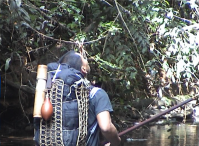EngageMedia’s Operations Manager and APC board member, Andrew Garton, is also a film-maker, media artist and composer. In October Andrew completed the micro-docs series, Sarawak Gone. Micro-docs are short format documentaries. The series was produced to sustain awareness to the persistent decline of indigenous life and culture in East Malaysia on the island of Borneo.
Sarawak Gone was made with anything, supported by countless hours of voluntary production, funded in part by people who deeply care about human rights and created in collaboration, and often in production with the communities themselves. The result is a 5 episode series, a culmination of three years work.
The entire work is open licensed. Where ever possible, the materials gathered and produced are returned to the communities who participated in the project. This content is also available for re-use, for free, to further the efforts of those who seek to protect the native customary rights of some of the most marginalised people in Malaysia.
The Headman
 Penan in the Ulu Baram, Sarawak On the 23 October 2007 Kelesau Naan, the Headman of the Penan village, Long Kerong, left his wife at a rest area in the forest to check on his traps. He never returned. Two months later his remains were found scattered across the Segita River.
Penan in the Ulu Baram, Sarawak On the 23 October 2007 Kelesau Naan, the Headman of the Penan village, Long Kerong, left his wife at a rest area in the forest to check on his traps. He never returned. Two months later his remains were found scattered across the Segita River.
The Headman is the final episode in the Sarawak Gone series. Sarawak Gone raises awareness to the gradual decimation of the indigenous life and culture of Sarawak, the struggle to maintain customary right to land and the rapidly decreasing habitats that are also home to countless protected and endangered flora and fauna. These issues are described through the plight of two communities whose rights to their customary ancestral land is being contested and in some instances, fought over.
Sarawak is one of two Malaysian states on the island of Borneo and is home to more than 40 unique sub-ethnic groups, or Dayaks. These include the Penan, Iban, Bidayuh, Kenyah and Kelabit. The race to extract as much of Sarawak’s resources has been a concern for more than three decades and yet the plunder continues.
Watch the Sarawak Gone series, download scripts and read background materials.
It ain’t over yet
 A community assisted micro-docThere’s a kind of anti-climax when one gets to the end of a project, but not this one. Despite completing the last official episode of this series, it’s far from over.
A community assisted micro-docThere’s a kind of anti-climax when one gets to the end of a project, but not this one. Despite completing the last official episode of this series, it’s far from over.
As I write The Headman is gradually populating personal walls on Facebook, various blogs and websites in a bid to keep the issues it raises not only in public view, but that we remember the legacy left by Kelesau Naan who disappeared three years ago.
Kelesau was known to have described the Penan as “mushrooms of the forest”. This statement resonates with a deep and profound knowledge of the connectedness of all things. As mushrooms grow from spore beneath the surface of the soil, so too do humans grow, feed and thrive from the forest floor to the canopies that protect them.
I learnt a great deal during my brief stay in Long Kerong. The Penan take nothing for-granted. Their needs are simple by our standards, but their way of life is immeasurably rich. For those that have seen life beyond the forest, they say this world robs them of their independence and way of life. That’s not to say they’re entirely against development. It wouldn’t take much to improve their standard of living. Solar power for lighting and refrigeration, improved and frequent access to health services and teachers that aren’t afraid to venture into and live amongst these people in the forests. But remove the Penan from the forest, both the people and tong tana, the closest term the Penan have for forest, will suffer.
Ethnocide
What we are witnessing with the removal of indigenous peoples from their customary lands is ethnocide. The anthropologist David Maybury-Lewis describes this as “the destruction of a people’s way of life” and notes that it’s considered acceptable and “appropriate” policy by the Malaysian government.
It takes only a single generation for entire communities to be denuded of their traditional knowledge, customs and way of life. I’ve seen it. In 20 years of work in Sarawak, supporting the efforts of my colleagues there, travelling to far flung communities and seeing the despair in the faces of elderly Dayaks, the loss to them and us is immeasurable.
Since 1999, when I started shooting there, over 20% of the remaining 25% of native rainforest’s I’d flown over, driven through or traced on maps has been torn out, leaving the forest to the scourge of palm oil where nothing but rats and snake survive. The rattan, forest foods and medicines, impossible to comprehend volume of species, both flora and fauna, and as ethnobotanist Wade Davis laments, a unique vision of life is being lost forever.
The prognosis may be dire, but I can only hope and persist in my work and support that of my colleagues, that it may not be as tragic as it seems today.
Acknowledgements
Sarawak Gone has been made with anything, for any one and available across the widest possible platforms. It would not have been possible to produce this work without the support of the APC, apc.au, Wind & Sky Productions, David Nerlich, Komas, Bruno Manser Fonds, Dunmoochin Foundation, EngageMedia, Pro REGENWALD, Sarawak Access and Umverteilen!